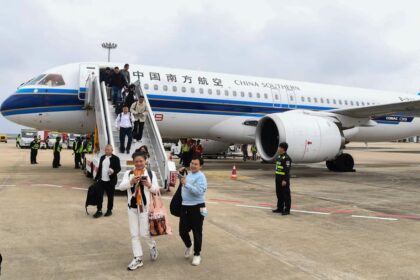Foreign Workers Quadruple in Rural Japan: A New Era for the Countryside
In a dramatic shift over the past decade, the number of foreign-born workers has more than quadrupled in seven Japanese prefectures, signaling a profound transformation in the country’s rural regions. Once known for their insularity and aging populations, Japan’s countryside is now increasingly reliant on immigrants to keep local economies afloat. This surge in foreign labor is not only reshaping the demographic landscape but also challenging long-held notions about national identity, integration, and the future of rural Japan.
- Foreign Workers Quadruple in Rural Japan: A New Era for the Countryside
- Why Are Foreign Workers Flocking to Rural Japan?
- Japan’s Immigration Policy: From Reluctance to Reform
- Integration Challenges: Beyond the Numbers
- Policy Innovations and the Path Forward
- Broader Implications: Toward a More Inclusive Society?
- In Summary
As Japan grapples with a shrinking and aging population, the influx of foreign workers has become a lifeline for small towns and villages struggling to fill jobs in agriculture, manufacturing, healthcare, and other essential sectors. But this rapid change also brings new challenges—both for the newcomers and the communities that host them.
Why Are Foreign Workers Flocking to Rural Japan?
Japan’s population peaked in 2008 and has been declining ever since. The fertility rate remains stubbornly low, and the working-age population is shrinking at an alarming rate. Rural areas, in particular, have been hit hardest by depopulation, with young Japanese moving to cities and local industries left desperate for labor.
To address these challenges, the Japanese government has gradually opened its doors to foreign workers. While immigration has long been a sensitive topic in Japan, economic necessity has forced a shift in policy. In recent years, a series of reforms have made it easier for foreigners to work in sectors facing acute labor shortages, especially in rural regions.
According to a survey by The Asahi Shimbun, the highest increases in foreign workers are now being seen in rural prefectures rather than urban centers. Prefectures like Hokkaido, Miyazaki, Saga, Kagoshima, Okinawa, and Nagasaki have recorded growth rates exceeding 15 percent in their foreign resident populations. This trend is driven by local governments actively seeking international agreements and partnerships to secure a steady supply of foreign labor.
Local Governments Compete for Talent
With the labor shortage intensifying, municipalities are racing to attract and retain foreign workers. Many have established agreements with foreign municipalities and universities, offering support such as Japanese language education, housing subsidies, and daily life assistance. These measures are designed to make rural areas more attractive to newcomers and to stem the exodus of workers to urban centers.
Ehime Prefecture, for example, highlights the importance of public involvement in creating a secure system for both foreign workers and local companies. Wakayama Prefecture notes that such agreements make it easier to establish stable sending and receiving systems. The source countries for foreign labor are also diversifying, with Vietnam, China, India, and Nepal now among the top partners.
Japan’s Immigration Policy: From Reluctance to Reform
Historically, Japan has had one of the lowest proportions of foreign-born residents among developed countries. Immigration policy was tightly controlled, with a focus on skilled professionals and limited pathways for low- and mid-skilled workers. However, the demographic crisis has forced a rethinking of these policies.
In 2019, Japan introduced the Specified Skilled Worker (SSW) system, allowing mid-skilled foreign nationals to work in industries with severe labor shortages and providing a path to long-term employment and residency. This was a significant departure from the previous Technical Intern Training Program (TITP), which required participants to return home after a few years and was criticized for labor rights abuses and limited job mobility.
Further reforms are on the horizon. In 2027, the TITP will be replaced by the Employment for Skill Development (ESD) Program, which aims to offer better training, improved employment conditions, and greater job mobility for foreign workers. The new system is designed to align more closely with the SSW, creating a clearer pathway from skills development to long-term employment and even permanent residency.
Government Targets and Economic Imperatives
Japan’s reliance on foreign labor is set to deepen. According to public think tanks and the Japan International Cooperation Agency (JICA), the country will need to quadruple its foreign workforce by 2040—reaching 6.74 million—to sustain projected economic growth. This would represent a dramatic increase from the current 1.72 million foreign workers, who already make up about 2.5 percent of the workforce.
JICA president Shinichi Kitaoka has emphasized the urgency of making Japan more attractive to foreign workers, warning that competition for talent will intensify globally. Without sufficient foreign labor, Japan risks falling short of its economic goals and facing even greater challenges in supporting its aging population.
Integration Challenges: Beyond the Numbers
While the influx of foreign workers is helping to revitalize rural economies, integration remains a significant challenge. Many foreign workers, especially those from Southeast Asia, face language barriers, cultural differences, and limited access to support services. Unlike internal migrants from Japanese cities, foreign workers often lack the resources and networks needed to navigate life in rural Japan.
Academic research highlights a “hierarchization” of migrants by nationality, with foreign workers often rendered invisible and marginalized in rural communities. There is no comprehensive national policy framework for immigrant integration, leaving local governments to develop their own approaches—often with mixed results.
According to the East Asia Forum, less than 10 percent of Japan’s villages and towns have a formal plan for multicultural coexistence, compared to nearly half of cities. This unevenness means that while some rural areas are making strides in supporting foreign residents, others lag far behind.
Institutional and Social Barriers
Local governments often lack the specialized skills and resources needed to support integration. Civil servants rotate between offices every few years, hindering the accumulation of institutional knowledge about immigrant needs. Budget constraints and competing priorities further limit the effectiveness of integration programs.
Some municipalities have hired staff of foreign origin to help with outreach and communication, providing a vital link between foreign residents and local services. However, these positions are often precarious and dependent on short-term contracts or fluctuating budgets.
Social attitudes also play a role. While there has been no significant populist backlash against immigration in Japan—unlike in some European countries—foreigners still face challenges related to language, discrimination, and cultural adaptation. For example, the growing Muslim population in Japan has highlighted issues such as the lack of burial sites for Islamic customs and limited access to halal food and prayer spaces.
Policy Innovations and the Path Forward
Recognizing these challenges, the Japanese government and local authorities are experimenting with new approaches to attract and retain foreign talent. The upcoming ESD program will offer three years of skills development, improved employment conditions, and stronger labor protections. The aim is to create a more welcoming environment that encourages foreign workers to stay long-term and contribute to local communities.
Municipalities are also offering incentives such as tuition subsidies for foreign students, housing support, and grants for workers who remain in the area for several years. These measures are designed not only to attract new arrivals but also to prevent the drift of foreign workers to larger cities, where wages and social opportunities may be more appealing.
Experts argue that Japan must do more to support integration, including:
- Expanding language education and job training programs
- Improving access to healthcare and social services
- Enacting anti-discrimination laws and promoting diversity in the workplace
- Facilitating family reunification and long-term residency
- Developing a national “toolkit” of resources for local governments
As Japan’s foreign workforce grows, the country’s approach to immigration and integration will play a critical role in determining whether rural areas can truly be revitalized and whether newcomers can build fulfilling lives in their adopted communities.
Broader Implications: Toward a More Inclusive Society?
The quadrupling of foreign workers in rural Japan is more than just a demographic trend—it is a test of the country’s ability to adapt to a rapidly changing world. The success or failure of these efforts will have far-reaching implications for Japan’s economy, social cohesion, and global competitiveness.
Panel discussions hosted by JICA and other organizations have emphasized the need for institutional reform and a shift in mindset. Rather than viewing foreign workers solely as economic resources, Japan is being urged to become a “country of choice” for global talent, embracing diversity and fostering co-creative communities where everyone can thrive.
Some rural leaders are already taking up this challenge. Governors in Gunma and Kumamoto prefectures have highlighted efforts to create safe environments, career development opportunities, and social value for both Japanese and non-Japanese residents. Universities and business federations are calling for stronger human rights protections and more inclusive policies.
Yet, as Nikkei Asia notes, the central government has yet to adopt a comprehensive national immigration policy, leaving much of the work to local governments. This decentralized approach has produced both innovation and inconsistency, with some regions leading the way and others struggling to keep up.
In Summary
- The number of foreign workers in rural Japan has more than quadrupled in several prefectures over the past decade, driven by labor shortages and demographic decline.
- Local governments are actively competing to attract and retain foreign talent, offering support measures and forging international partnerships.
- Japan’s immigration policy is evolving, with new systems like the Specified Skilled Worker and upcoming Employment for Skill Development programs aimed at long-term integration.
- Integration challenges persist, especially in rural areas, due to language barriers, limited support services, and uneven policy implementation.
- Experts and local leaders are calling for more comprehensive national policies, better integration support, and a shift toward viewing foreign workers as partners in building inclusive, vibrant communities.












